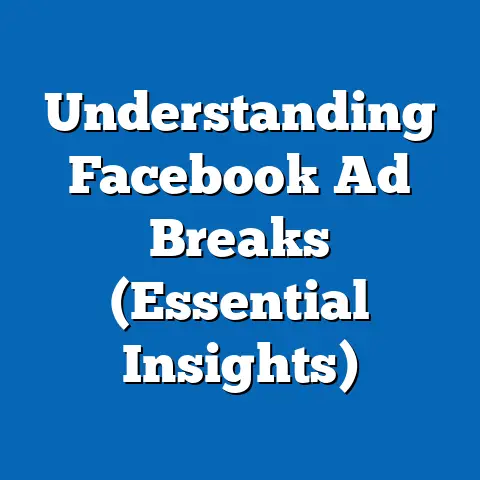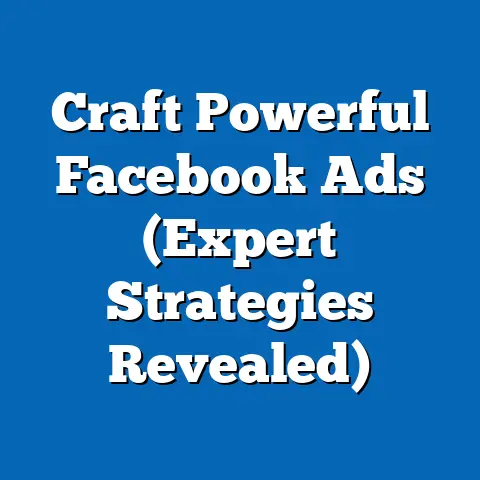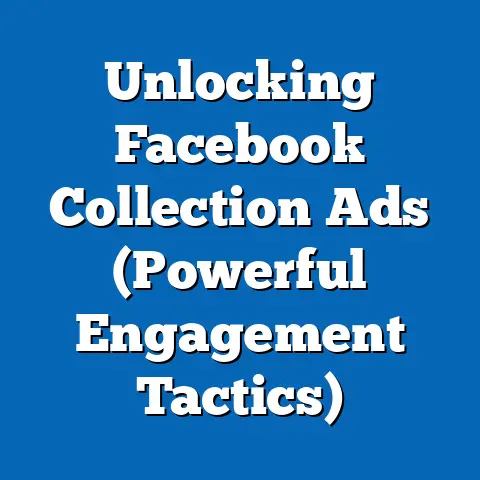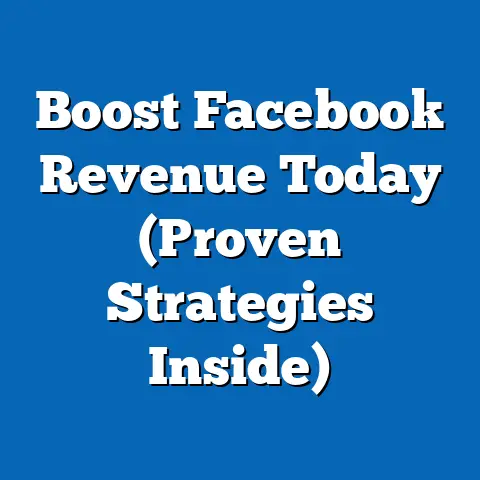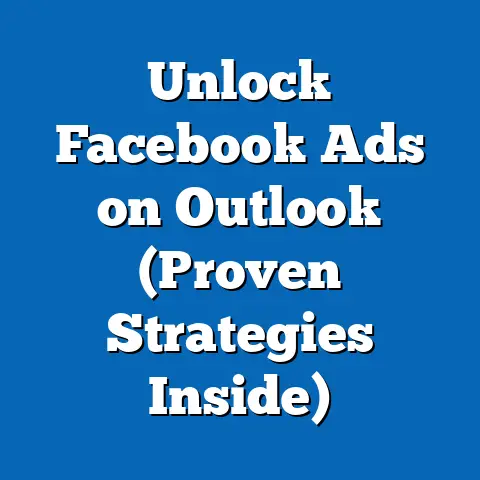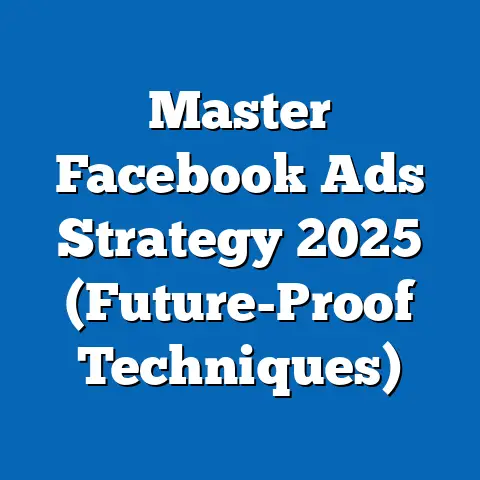Mastering Facebook Ads: Tofu, Mofu, Bofu Unleashed (Pro Insights)
Have you ever felt like you’re throwing money into a black hole with your Facebook ads? You’re not alone. So many marketers struggle to connect with the right audience at the right time. It’s like trying to sell ice to an Eskimo – a mismatch between your message and their needs. The real challenge isn’t just about creating eye-catching ads; it’s about understanding where your potential customers are in their buying journey and tailoring your message accordingly.
How do you capture the attention of someone who has never heard of your brand? What strategies should you employ to nurture interest and convert leads into paying customers? These are the questions that keep marketers up at night. The answer lies in mastering the marketing funnel – Tofu (Top of Funnel), Mofu (Middle of Funnel), and Bofu (Bottom of Funnel). Missteps at any stage can lead to wasted ad spend and lost opportunities. I’ve seen countless campaigns falter because they tried to close a sale with someone who barely knew the brand existed. It’s like asking for a marriage proposal on the first date – a bit too much, too soon.
In this article, I’ll walk you through the intricacies of each funnel stage and show you how to create Facebook ad campaigns that resonate with your audience, no matter where they are in their journey. I’ll share my personal experiences, successful strategies, and common pitfalls to avoid. Let’s dive in and transform your Facebook ad game!
Understanding the Marketing Funnel
The marketing funnel is a visual representation of the customer journey, from initial awareness to final purchase. It’s a model that helps marketers understand how consumers interact with a brand at each stage of their decision-making process. Think of it as a roadmap that guides your potential customers from being complete strangers to loyal advocates.
The funnel is typically divided into three main stages: Tofu (Top of Funnel), Mofu (Middle of Funnel), and Bofu (Bottom of Funnel). Each stage requires a different approach, content strategy, and ad format to effectively engage and move prospects further down the funnel. Understanding the psychology behind consumer behavior at each stage is crucial for crafting targeted and impactful ad campaigns.
Tofu (Top of Funnel)
The primary goal of Tofu campaigns is brand awareness and audience reach. At this stage, you’re targeting cold traffic – people who have never heard of your brand or your products/services. These individuals are usually seeking general information, entertainment, or solutions to their problems. Your objective is to introduce your brand and capture their attention without being overly salesy.
Key characteristics of Tofu audiences include:
- Cold Traffic: They are completely new to your brand.
- Unaware of the Brand: They have no prior knowledge of your company or what you offer.
- Seeking Information: They are looking for educational content, answers to their questions, or solutions to their problems.
I remember when I launched my first Tofu campaign; I made the mistake of immediately pushing my product’s features. It flopped miserably. I quickly learned that Tofu is about building trust and providing value upfront. Instead, I shifted my focus to creating informative blog posts and engaging videos that addressed common pain points in my industry. This approach not only increased brand awareness but also positioned me as a thought leader in my niche.
Mofu (Middle of Funnel)
Mofu campaigns are all about nurturing leads and building relationships. At this stage, your audience has some awareness of your brand and is evaluating their options. They are interested in learning more about your products/services but are not yet ready to make a purchase. Your goal is to provide them with valuable information that helps them make an informed decision.
Mofu audiences typically:
- Have Some Awareness: They know your brand exists and are somewhat familiar with what you offer.
- Evaluating Options: They are comparing different solutions to their problems, including your competitors.
- Seeking More Information: They are looking for detailed product information, case studies, and testimonials.
I once ran a Mofu campaign that offered a free e-book in exchange for email sign-ups. The e-book provided in-depth information about the benefits of my product and how it solved specific problems. This not only generated high-quality leads but also allowed me to segment my audience based on their interests and tailor my messaging accordingly. I found that personalized communication significantly improved engagement and conversion rates.
Bofu (Bottom of Funnel)
Bofu campaigns focus on conversion and sales. At this stage, you’re targeting warm leads who are ready to make a purchase decision. They are familiar with your brand, understand the value of your products/services, and are actively considering buying from you. Your objective is to provide them with a compelling offer and remove any remaining barriers to purchase.
Bofu audiences are usually:
- Warm Leads: They have shown a strong interest in your brand and products/services.
- Ready to Purchase: They are actively considering making a purchase.
- Seeking a Final Push: They may need a special offer, discount, or guarantee to seal the deal.
I’ll never forget a Bofu campaign I ran during the holiday season. I offered a limited-time discount on my product, combined with a money-back guarantee. The results were phenomenal. The sense of urgency and the reduced risk motivated a large number of prospects to finally make a purchase. This experience taught me the power of creating compelling offers that cater to the specific needs and concerns of Bofu audiences.
Takeaway: Understanding the marketing funnel and tailoring your Facebook ad strategy to each stage is crucial for maximizing your ROI. Each stage requires a different approach, content strategy, and ad format to effectively engage and convert prospects.
Crafting Effective Tofu Ads
Creating effective Tofu ads is all about making a great first impression. You’re introducing your brand to a completely new audience, so your message needs to be engaging, informative, and non-intrusive. The goal is to capture their attention, pique their interest, and encourage them to learn more about you.
Content Strategy for Tofu
The types of content that resonate with Tofu audiences are typically educational, entertaining, or inspirational. Avoid overly promotional content or direct sales pitches at this stage. Instead, focus on providing value upfront and building trust with your audience.
Some examples of successful Tofu content include:
- Educational Videos: Create short, informative videos that address common pain points in your industry. These videos can provide valuable tips, insights, or tutorials that help your audience solve their problems.
- Blog Posts: Write blog posts that cover a wide range of topics related to your niche. These posts should be well-researched, informative, and engaging.
- Infographics: Create visually appealing infographics that present complex information in an easy-to-understand format. Infographics are great for capturing attention and sharing valuable insights.
For example, if you’re selling fitness equipment, you could create a Tofu video that demonstrates simple exercises people can do at home. Or, if you’re a financial advisor, you could create a blog post that explains the basics of investing. The key is to provide value to your audience without directly selling your products or services.
When measuring the effectiveness of Tofu ad campaigns, focus on metrics such as:
- Reach: The number of unique people who saw your ad.
- Impressions: The number of times your ad was displayed.
- Engagement: The number of likes, comments, shares, and clicks your ad received.
- Website Traffic: The number of people who clicked on your ad and visited your website.
I once ran a Tofu campaign that promoted a series of blog posts on my website. I focused on creating high-quality, informative content that addressed common questions in my industry. The campaign generated a significant increase in website traffic and brand awareness. I also noticed that people who visited my website through the Tofu ads were more likely to engage with my content and eventually become customers.
Ad Formats and Best Practices
Facebook offers a variety of ad formats that are suitable for Tofu campaigns. Some of the most effective options include:
- Carousel Ads: These ads allow you to showcase multiple images or videos in a single ad unit. They are great for telling a story, highlighting different products or services, or showcasing various features.
- Video Ads: Video ads are highly engaging and can be used to capture attention and convey your message effectively. They are ideal for demonstrating how your product works, sharing customer testimonials, or creating a memorable brand experience.
- Image Ads: Image ads are simple yet effective for creating brand awareness and driving traffic to your website. Choose high-quality, visually appealing images that capture the essence of your brand and resonate with your target audience.
When creating Tofu ads, keep the following best practices in mind:
- Use Eye-Catching Visuals: Choose high-quality images or videos that grab attention and convey your message effectively.
- Write Compelling Copy: Craft ad copy that is clear, concise, and engaging. Highlight the benefits of your product or service and explain how it can solve your audience’s problems.
- Include a Clear Call to Action: Tell your audience what you want them to do next. Use a clear and concise call to action, such as “Learn More,” “Visit Our Website,” or “Download Our Free Guide.”
I remember struggling to create effective Tofu ads at first. My visuals were bland, my copy was uninspired, and my call to action was weak. After experimenting with different approaches, I discovered that the key was to focus on creating ads that were visually appealing, informative, and engaging. I started using brighter colors, more compelling headlines, and clearer calls to action. The results were dramatic. My click-through rates soared, and I generated significantly more traffic to my website.
Targeting and Audience Insights
Effective targeting is crucial for the success of any Facebook ad campaign, especially Tofu campaigns. You need to reach the right audience with the right message to maximize your ROI. Facebook offers a variety of targeting options that allow you to reach specific demographics, interests, and behaviors.
Some of the most effective targeting options for Tofu campaigns include:
- Interest-Based Targeting: Target people based on their interests, hobbies, and passions. This is a great way to reach people who are likely to be interested in your product or service.
- Lookalike Audiences: Create a lookalike audience based on your existing customers or website visitors. This allows you to reach people who share similar characteristics and behaviors with your best customers.
Facebook’s Audience Insights tool can be invaluable for refining your Tofu targeting strategies. This tool provides detailed information about your target audience, including their demographics, interests, behaviors, and purchase habits. You can use this information to create more targeted and effective ad campaigns.
I once used Facebook’s Audience Insights tool to research my target audience for a Tofu campaign. I discovered that my audience was not only interested in my industry but also in related topics that I hadn’t considered before. I used this information to expand my targeting and reach a wider audience. The results were impressive. My reach increased significantly, and I generated a higher number of leads at a lower cost.
Takeaway: Crafting effective Tofu ads requires a focus on providing value, creating engaging content, and targeting the right audience. By following these best practices, you can create campaigns that generate brand awareness, drive traffic to your website, and build a loyal customer base.
Nurturing Leads with Mofu Ads
Once you’ve captured the attention of your audience with Tofu ads, it’s time to nurture those leads with Mofu ads. The goal of Mofu campaigns is to build relationships, provide valuable information, and guide prospects further down the sales funnel.
Content Strategy for Mofu
The types of content that effectively nurture leads are typically more detailed and informative than Tofu content. At this stage, your audience is interested in learning more about your products/services and how they can solve their specific problems.
Some examples of effective Mofu content include:
- Case Studies: Showcase how your products/services have helped other customers achieve their goals. Case studies provide social proof and demonstrate the value of your offerings.
- Webinars: Host webinars that provide in-depth information about your products/services, industry trends, or best practices. Webinars are a great way to engage with your audience and answer their questions in real-time.
- Comparison Guides: Create comparison guides that highlight the differences between your products/services and your competitors. These guides can help prospects make an informed decision and choose the best solution for their needs.
For example, if you’re selling software, you could create a Mofu case study that showcases how your software has helped a customer improve their productivity. Or, if you’re a real estate agent, you could host a webinar that provides tips for buying a home in the current market. The key is to provide valuable information that helps your audience make an informed decision.
When measuring the effectiveness of Mofu ad campaigns, focus on metrics such as:
- Lead Generation: The number of leads generated from your ad campaigns.
- Engagement: The number of likes, comments, shares, and clicks your ad received.
- Website Traffic: The number of people who clicked on your ad and visited your website.
- Conversion Rate: The percentage of leads who convert into customers.
I once ran a Mofu campaign that offered a free e-book in exchange for email sign-ups. The e-book provided in-depth information about the benefits of my product and how it solved specific problems. This not only generated high-quality leads but also allowed me to segment my audience based on their interests and tailor my messaging accordingly. I found that personalized communication significantly improved engagement and conversion rates.
Ad Formats for Mofu
Facebook offers a variety of ad formats that are suitable for Mofu campaigns. Some of the most effective options include:
- Collection Ads: These ads allow you to showcase multiple products or services in a visually appealing format. They are great for highlighting different features, benefits, or use cases.
- Lead Generation Ads: Lead generation ads allow you to collect leads directly on Facebook without requiring prospects to visit your website. These ads are ideal for capturing contact information, such as email addresses and phone numbers.
When crafting ad copy for Mofu campaigns, keep the following best practices in mind:
- Highlight the Benefits: Focus on the benefits of your product or service rather than just the features. Explain how it can solve your audience’s problems and improve their lives.
- Use Strong Call to Actions: Tell your audience what you want them to do next. Use a clear and concise call to action, such as “Download Our Free Guide,” “Sign Up for Our Webinar,” or “Learn More About Our Product.”
- Address Common Objections: Anticipate and address common objections that prospects may have about your product or service. This can help overcome any remaining barriers to purchase.
I remember struggling to create effective Mofu ads at first. My ad copy was too generic, my visuals were uninspired, and my call to action was weak. After experimenting with different approaches, I discovered that the key was to focus on creating ads that were informative, engaging, and persuasive. I started highlighting the benefits of my product, using stronger calls to action, and addressing common objections. The results were dramatic. My lead generation rates soared, and I generated significantly more qualified leads.
Retargeting Strategies
Retargeting is a powerful strategy for nurturing leads in the Mofu stage. It allows you to target people who have previously interacted with your brand, such as website visitors, email subscribers, or social media followers. By retargeting these individuals, you can re-engage them with relevant content and encourage them to take the next step in the sales funnel.
To set up retargeting campaigns on Facebook, you’ll need to install the Facebook Pixel on your website. The Pixel is a small piece of code that tracks website visitors and their actions. You can then use this data to create custom audiences for retargeting.
Some effective retargeting tactics include:
- Website Retargeting: Target people who have visited specific pages on your website. This is a great way to re-engage prospects who have shown a strong interest in your products/services.
- Email Retargeting: Target people who are on your email list. This allows you to reach prospects who have already expressed an interest in your brand.
- Social Media Retargeting: Target people who have interacted with your social media posts or ads. This is a great way to re-engage prospects who are already familiar with your brand.
I once ran a retargeting campaign that targeted people who had visited my product page but had not yet made a purchase. I showed them an ad that highlighted the benefits of my product and offered a special discount. The results were impressive. The campaign generated a significant increase in sales and improved my overall conversion rate.
Takeaway: Nurturing leads with Mofu ads requires a focus on providing valuable information, creating engaging content, and using effective retargeting strategies. By following these best practices, you can build relationships with your audience, guide them further down the sales funnel, and increase your conversion rates.
Closing Sales with Bofu Ads
Content Strategy for Bofu
The content strategy for Bofu campaigns is focused on persuasion and driving conversions. At this stage, your audience is ready to make a purchase decision, so your messaging should be direct, compelling, and persuasive.
Some examples of persuasive content types include:
- Testimonials: Showcase positive reviews and testimonials from satisfied customers. Testimonials provide social proof and build trust with your audience.
- Limited-Time Offers: Create a sense of urgency by offering a limited-time discount or promotion. This can motivate prospects to make a purchase before the offer expires.
- Product Demos: Demonstrate how your product works and highlight its key features and benefits. Product demos can help prospects visualize themselves using your product and understand its value.
For example, if you’re selling e-commerce products, you could create a Bofu ad that showcases positive customer reviews and offers a limited-time discount. Or, if you’re a service provider, you could create a Bofu ad that offers a free consultation or trial period. The key is to provide a compelling offer that motivates prospects to take action.
When measuring the effectiveness of Bofu ad campaigns, focus on metrics such as:
- Conversion Rate: The percentage of leads who convert into customers.
- Return on Ad Spend (ROAS): The amount of revenue generated for every dollar spent on advertising.
- Cost Per Acquisition (CPA): The cost of acquiring a new customer through your ad campaigns.
I once ran a Bofu campaign that offered a limited-time discount on my product, combined with a money-back guarantee. The results were phenomenal. The sense of urgency and the reduced risk motivated a large number of prospects to finally make a purchase. This experience taught me the power of creating compelling offers that cater to the specific needs and concerns of Bofu audiences.
Ad Formats for Bofu
Facebook offers a variety of ad formats that are suitable for Bofu campaigns. Some of the most effective options include:
- Dynamic Ads: Dynamic ads automatically showcase products or services to people who have previously interacted with your website or app. These ads are highly personalized and relevant, which can lead to higher conversion rates.
- Offer Claims: Offer claims allow you to create and promote special offers on Facebook. These offers can be redeemed online or in-store.
When creating ad copy for Bofu campaigns, keep the following best practices in mind:
- Create Urgency: Use language that creates a sense of urgency, such as “Limited Time Offer,” “Sale Ends Soon,” or “Don’t Miss Out.”
- Leverage Social Proof: Include customer testimonials, ratings, or reviews in your ad copy.
- Provide a Clear Call to Action: Tell your audience what you want them to do next. Use a clear and concise call to action, such as “Buy Now,” “Shop Now,” or “Get Your Discount.”
I remember struggling to create effective Bofu ads at first. My ad copy was too generic, my offers were uninspired, and my call to action was weak. After experimenting with different approaches, I discovered that the key was to focus on creating ads that were persuasive, urgent, and highly relevant. I started using stronger calls to action, highlighting limited-time offers, and leveraging social proof. The results were dramatic. My conversion rates soared, and I generated significantly more revenue.
Optimizing for Conversions
Optimizing your Bofu ads for maximum conversion rates requires a focus on A/B testing, analyzing performance data, and creating a seamless landing page experience.
- A/B Testing: Test different ad copy, visuals, and offers to see what resonates best with your audience.
- Analyze Performance Data: Track your key metrics, such as conversion rate, ROAS, and CPA, to identify areas for improvement.
- Create a Seamless Landing Page Experience: Ensure that your landing page is relevant to your ad, easy to navigate, and optimized for conversions.
I once ran an A/B test on my Bofu ads to see which offer performed better: a percentage discount or a free gift with purchase. The free gift with purchase significantly outperformed the percentage discount. This insight allowed me to optimize my Bofu ads and increase my overall conversion rate.
Takeaway: Closing sales with Bofu ads requires a focus on providing a compelling offer, creating a sense of urgency, and optimizing for conversions. By following these best practices, you can maximize your ROI and drive significant revenue growth.
Analyzing and Optimizing Your Facebook Ads Strategy
Creating successful Facebook ad campaigns is not a one-time effort; it’s an ongoing process of analysis, optimization, and continuous improvement. To maximize your ROI, you need to track your key performance indicators (KPIs), conduct performance audits, and make data-driven decisions.
Key Performance Indicators (KPIs)
Key Performance Indicators (KPIs) are essential metrics that help you gauge the success of your Facebook ad campaigns. The KPIs you track will vary depending on the stage of the marketing funnel.
Here are some essential KPIs for each stage:
- Tofu:
- Reach: The number of unique people who saw your ad.
- Impressions: The number of times your ad was displayed.
- Engagement: The number of likes, comments, shares, and clicks your ad received.
- Website Traffic: The number of people who clicked on your ad and visited your website.
- Mofu:
- Lead Generation: The number of leads generated from your ad campaigns.
- Engagement: The number of likes, comments, shares, and clicks your ad received.
- Website Traffic: The number of people who clicked on your ad and visited your website.
- Conversion Rate: The percentage of leads who convert into customers.
- Bofu:
- Conversion Rate: The percentage of leads who convert into customers.
- Return on Ad Spend (ROAS): The amount of revenue generated for every dollar spent on advertising.
- Cost Per Acquisition (CPA): The cost of acquiring a new customer through your ad campaigns.
- Reach: The number of unique people who saw your ad.
- Impressions: The number of times your ad was displayed.
- Engagement: The number of likes, comments, shares, and clicks your ad received.
- Website Traffic: The number of people who clicked on your ad and visited your website.
- Lead Generation: The number of leads generated from your ad campaigns.
- Engagement: The number of likes, comments, shares, and clicks your ad received.
- Website Traffic: The number of people who clicked on your ad and visited your website.
- Conversion Rate: The percentage of leads who convert into customers.
- Conversion Rate: The percentage of leads who convert into customers.
- Return on Ad Spend (ROAS): The amount of revenue generated for every dollar spent on advertising.
- Cost Per Acquisition (CPA): The cost of acquiring a new customer through your ad campaigns.
Interpreting these metrics correctly is crucial for understanding the performance of your campaigns. For example, a high reach but low engagement in a Tofu campaign may indicate that your ad creative is not resonating with your audience. A low conversion rate in a Bofu campaign may suggest that your offer is not compelling enough or that your landing page is not optimized for conversions.
I remember when I first started running Facebook ads, I was overwhelmed by the amount of data available. I didn’t know which metrics to track or how to interpret them. After some trial and error, I realized that the key was to focus on the KPIs that were most relevant to my business goals. I created a dashboard that tracked my key metrics and used this data to make informed decisions about my ad campaigns.
Continuous Improvement
Continuous improvement is essential for maximizing your ROI on Facebook ads. You should always be testing new ad copy, visuals, offers, and targeting options to see what works best.
Here are some best practices for conducting performance audits and making data-driven decisions:
- Track Your KPIs: Monitor your key metrics on a regular basis to identify trends and patterns.
- Conduct A/B Tests: Test different ad copy, visuals, and offers to see what resonates best with your audience.
- Analyze Performance Data: Use the data you collect to identify areas for improvement.
- Make Data-Driven Decisions: Base your decisions on data rather than gut feeling.
- Stay Up-to-Date: Keep up with the latest Facebook ad features and best practices.
I once ran a performance audit on my Facebook ad campaigns and discovered that my cost per lead was significantly higher than my industry average. After analyzing my data, I realized that my targeting was too broad and that I was wasting money on unqualified leads. I narrowed my targeting and focused on reaching people who were more likely to be interested in my product. The results were dramatic. My cost per lead decreased significantly, and I generated more qualified leads.
Case Studies of Successful Campaigns
Many brands have successfully implemented Tofu, Mofu, and Bofu strategies on Facebook. Analyzing these case studies can provide valuable insights and inspiration for your own campaigns.
For example, a well-known clothing brand might use Tofu ads to promote their brand and build awareness, Mofu ads to showcase their latest collections and offer styling tips, and Bofu ads to offer discounts and promotions to drive sales.
Analyzing what worked in each case and the lessons learned can help you develop more effective Facebook ad strategies.
Takeaway: Analyzing and optimizing your Facebook ads strategy is an ongoing process that requires a focus on tracking KPIs, conducting performance audits, and making data-driven decisions. By following these best practices, you can continuously improve your campaigns and maximize your ROI.
Conclusion
Mastering Facebook ads across all funnel stages is not just about creating visually appealing ads; it’s about understanding the psychology of your audience at each stage of their buying journey. A well-rounded strategy that addresses Tofu, Mofu, and Bofu can lead to sustainable business growth, increased brand loyalty, and a significant boost in revenue.
I’ve seen firsthand the transformative power of a well-executed Facebook ads strategy. It’s not just about driving traffic; it’s about building relationships, providing value, and guiding prospects towards becoming loyal customers.
So, I encourage you to apply the insights shared in this article to enhance your Facebook advertising efforts. Experiment with different ad formats, targeting options, and content strategies. Track your KPIs, analyze your data, and continuously improve your campaigns.
Remember, the journey to mastering Facebook ads is a marathon, not a sprint. It requires patience, persistence, and a willingness to learn and adapt. But with the right knowledge, tools, and strategies, you can navigate the complexities of Facebook ads and achieve your marketing goals.
I hope this article has inspired confidence in your ability to create effective Facebook ad campaigns that drive results. Now, go out there and unleash the power of Tofu, Mofu, and Bofu!

